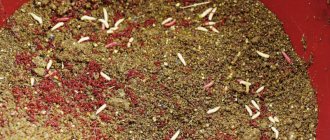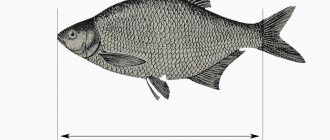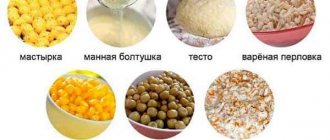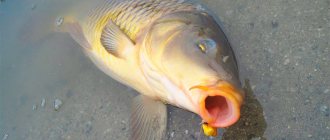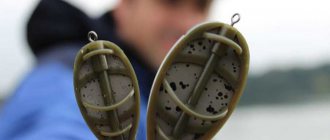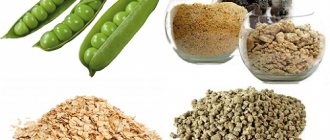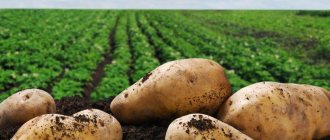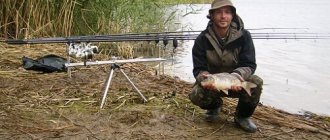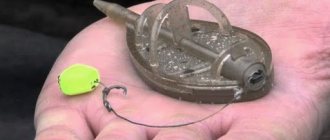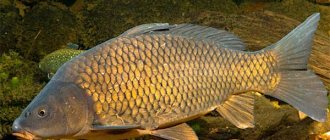Carp is a large fish that lives in many rivers and large lakes. It is also successfully bred in artificial reservoirs. It is generally accepted that this species was created by breeders as a result of many years of work.
Many call it a domesticated carp, but in reality, carp existed long before human intervention in the natural evolution of the underwater world. They represented two different forms: river and lake. Representatives of the first were distinguished by an elongated body, which greatly simplified life on the current, while the second lived in stagnant water, moved less, ate well, quickly gained weight and grew not only in length, but also upward. It was wild lake carp, which demonstrated the ability to survive a lack of oxygen, that were settled by humans over large areas. And without any special selection efforts. It was the same carp that is now called common. And improved species (hybrid forms) bred under artificial conditions began to appear relatively recently, about a century and a half ago. This is the well-known mirror carp, which today can be bought in any supermarket, naked (less common), Siamese, carp (bred in the 80s of the last century) and several exotic subspecies like the decorative koi.
Carp fish - description
The common (scaly) carp, which is most often found in our reservoirs, is easily recognized by several characteristic external features. This:
a rather thick powerful body protected by cycloid scales;- wide belly of a light shade;
- sides shimmering with a golden sheen;
- large mouth capable of stretching forward;
- double nostrils;
- two pairs of small antennae that serve as organs of touch (located on the upper lip, above the corners of the mouth);
- high-set eyes with small pupils;
- dark back compared to sides.
A layer of mucus protects the fish’s body from parasites and pathogenic microbes, which also improves thermoregulation and reduces water resistance when moving.
Carp fish live up to 50 years, and in favorable conditions even longer, growing to impressive sizes and gaining a mass of 40-50 kg. Such specimens, unfortunately, are rarely caught on a hook; the average size of caught specimens does not exceed 5 kg. But this is more than enough to attract the attention of many anglers. Catching even a 3-kilogram carp will arouse the envy and respect of your colleagues. But first you need to make him bite, hook him correctly, pull him to the shore and bring him into the landing net, and this is not so easy. The closer to the coastline, the stronger he will resist; he will certainly try to insert the rig into the grass or break the fishing line with one powerful jerk.
Habitats
Carp is distributed in temperate latitudes on almost all continents. For life, stagnant bodies of water and river areas with weak currents, soft bottoms and thickets of aquatic vegetation are best suited for it. The optimal depth is 2-8 meters. He does not like open places with a flat bottom surface and avoids such “plates”. An angler targeting carp should first look for a variety of cover, regardless of its origin. This could be a snag, a flooded bush, or simply thickets of aquatic vegetation. In such areas, the carp feels safe, so it spends most of its time. On rivers, it inhabits quiet bays, where there is a lot of food and there is no need to fight the flow.
Bait selection
Classic carp fishing involves the use of boilies, corn, tiger nuts, pellets, while mainly tying hair tackle. Boilies come in bait and bait types. Floating and sinking species are used for bait.
Floating baits are mainly used simultaneously with other boilies, allowing the bait to be raised from the bottom so that it is easier for the fish to find it. Today there are different variations of floating baits, in particular artificial corn, pellets, maggots, etc.
There is also this silicone corn for carp fishing with different flavors, its advantage is that it stays well on the hook, but at the same time the carp quickly senses the catch and needs timely hooking
Small boilies for bait are mainly used with the addition of porridge or purchased bait in PVA bags. Additionally, the bait can be treated with concentrated dips that have different odors.
Hair snap is allied with corn
Diet
When it comes to food, carp is unpretentious; it is deservedly classified as an omnivorous underwater inhabitant. The “telescopic” mouth indicates that it feeds mainly from the bottom, filtering a 20-centimeter layer of soil and selecting nutritional components from it. He easily rubs hard objects with his wide, strong lips.
The daily menu of this fish consists of:
worms, leeches, insects and their larvae;- crustaceans and young crayfish (during the molting period);
- shellfish (especially likes barley meat);
- shoots of aquatic plants;
- caviar of all other types;
- larvae of tailless vertebrates (tadpoles).
In the absence of a sufficient amount of food, an adult may instinctively swallow a careless fry, as evidenced by unexpected catches. But carps never consciously hunt for live fish, and therefore are not considered predators.
In the warm season, this species readily takes fishermen’s vegetable baits such as pearl barley, potatoes, corn, peas, and compressed sunflower cake. Advanced carp fishing enthusiasts use store-bought and homemade boilies as bait - special round balls, which may contain fish meal, crushed grains, starch, milk proteins, various flavorings, aromas, dyes and substances with binding properties.
From all of the above, the conclusion suggests itself: carp is not a gourmet fish. He eats anything he finds edible, making it easy for anyone who wants to catch him.
Catching trophy carp in the Moscow region
" Back 12.09.2011 21:24Catching large carp in the paid pond “Silver Bowl” on Kievskoye Highway, Moscow Region requires certain knowledge and skills. We will try to tell you in this article about what gear is best to use for carp fishing, how to choose a body of water, how to tame a big fish and then catch it. Step one: choose a body of water.
For carp fishing, a good paid reservoir is suitable, in which the bottom is cleaned and aerated. Which is regularly stocked with fish. To which for many years not a single claim of non-compliance with standards has been made. You can fish for carp here all year round. It is especially successful in early autumn, when the water becomes cool. After all, during these months the fish tries to fill up on fat reserves before the onset of cold weather. It would be a shame not to take advantage of this circumstance to hook the giant. By the way, what should it be like for carp fishing with a fishing rod to end in victory for the fisherman?
Tackle for carp fishing: Carp is a very strong fish. Therefore, to catch carp you need to choose • a fishing line of a solid working diameter (0.22-0.25) with average elongation, without memory, natural colors, since carp are picky about the color of the fishing line; • a rod with a large reserve of power and length; • feeder (a feeder from the German company Browning Force Feeder 13 ft is perfect); • the reel is very powerful (if it has a rear clutch - great); • a large hook made of thick wire (No. 4 - 0.68 mm from the Owner company) with a short sting, a regular, smooth bend and guaranteed sharp, which should be changed after catching each large fish;
• float – sensitive and invisible; • feeder (preferably from the Easy Speed feeder company). With this rig, the carp is almost in your hands. All that remains is to prepare a treat for the fish. Catching carp with boilies: The traditional menu for large fish - worms, maggots, beans and corn - has now been replaced by ready-made food. In particular, boilies. They retain the aroma for a long time, absorb moisture perfectly, can have any shade and attached to a hook using a hair mount, they stick to it perfectly. But the main advantage of such food is that boilies select prey. Only a huge carp can swallow a boilie. It will not attract small fish. And this is what is needed in this case. Another excellent feed option is pellets. It contains wheat, soy protein, gluten, a valuable set of various minerals and acids, flour - 3 types: rapeseed, soy, fish. Everything is absolutely natural and at reasonable prices. As an option, you can prepare your own food for catching large fish using cereals and hemp, pellets, boilies, and various aromatics. The ratio is as follows: feed component - 20%, approximately 40-60 - base, 20% fillers and 5% flavors. For feeder bait, you can use Expo products from Marcel Van Den Eynde. Or you can dream up. Take, for example, corn from a can and soak it in banana attractant from Marcel Van Den Eynde. A big fish will not be able to ignore the deep, tart taste and bright yellow color of an excellent royal meal. Especially during the onset of cold weather. And he will definitely be “captured.” Although, not a fact. Carp fishing is an eternal search for methods of baiting and catching carp. It's always an experiment. But that’s where the whole fun of fishing lies.
Good luck…
Alexey Fadeev
Paid fishing in the Moscow region, Kyiv highway, 25 km from the Moscow Ring Road © 2006-2011
Features of reproduction
Carp is a heat-loving fish, so in the spring it is in no hurry to spawn. It begins to spawn no earlier than the water warms up to a comfortable 18 degrees. Depending on weather conditions, this can happen as early as the last days of April, but usually spawning occurs in May, and if the spring turned out to be cold, then in the first half of June.
This fish reaches sexual maturity at the age of 4-5 years. The female, ready to spawn, is accompanied by a group of males (usually her peers). Together they look for suitable shallow water with a depth of no more than 0.5 meters, densely overgrown with grass. The female lays eggs for 3-4 days, and another week after the end of this process, fry hatch from the small eggs. At first, their food consists of nutrients from the yolk sac (embryo-organ), and when this supply runs out, they switch to zooplankton.
The hatched fry form large flocks, which gradually break up into groups of smaller numbers. Carp begin to lead an isolated lifestyle only in adulthood.
Carp fishing methods
Some lucky ones manage to catch a carp while fishing for predators on a spinning rod, but this is purely an accident. Purposefully fishing for carp is carried out in several proven ways:
Carp fishing is an activity for professionals who are not interested in other fish. This type of fishing requires the use of special gear, accessories and fairly large baits, which eliminates the possibility of catching small specimens. Avid carp fishermen are ready to wait for days for that one bite that will give them an unforgettable experience of fighting with a huge fish and a chance to take a photo with it for their fishing album.- Feeder fishing involves using a standard English donkey with a spring-type carp feeder. This is the most common method that allows you to fish promising points remote from the shore. Fishing with classic feeder gear is a kind of intermediate stage that almost every carp fisher has gone through.
- A float rod is another effective tool, especially on smaller bodies of water. With it you can count on success early in the morning and at dawn, when carp come close to the shore in search of food. The tackle must be strong enough to withstand the resistance of a large, strong fish.
Makushatnik is a unique invention of our grandfathers, which did not become an object of mass production. You can't buy it in the store. It is a lead sinker (usually flat) with leads, hooks and elastic bands for fixing the pressed crown in the shape of a cube. This structure can be cast with a strong rod equipped with a reel and strong line, or with an onboard rod when fishing from a boat. The principle of operation of the bait is as follows: the fish sucks the bait and retracts one of the hooks, which the fisherman hides in the cake before casting. After this, a loud ringing of the bell signals a bite.- Donka with a rubber shock absorber is also an outdated tackle, but not completely forgotten. In villages remote from large populated areas, where carp fishing has only been heard about, local fishermen successfully use it. The advantage of the elastic band (as this tackle is often called) is that the hooks return to the same baited point after fishing for prey or replacing the bait. You can feed in two ways: throw prepared balls by hand or put small portions of porridge on the main line at the junction with the leashes.
Grain carp bait
Cereals have been used to feed fish in general and carp in particular for centuries and are probably the most ancient type of bait used by humans when fishing. What makes them so popular among anglers? Why, despite the widespread use of modern highly effective types of bait, such as boilies and pellets, the composition of which is worked on by entire teams of specially trained people, grains continue to firmly hold their place in the arsenal of almost all carp anglers (from the best athletes to village grandfathers who continue to although it’s the old fashioned way, it’s very successful to catch carp on bamboo fishing rods with a goose feather float)?
There are many reasons for this. The first of these, perhaps, is the availability of grains. Unlike the aforementioned boilies and pellets, corn or wheat can be easily purchased or “obtained” in any remote village. The second is the relatively low cost of most types of grains (lately, perhaps, with the exception of hemp, which has become much more expensive). The third reason is the ease of storing and preparing grains and nuts. As for subjective reasons, that's probably all.
But there are also a number of objective reasons that make grains one of the most popular types of bait. Cereals are very attractive food items for carp. Firstly, fish in cultural reservoirs (and these are the ones we fish in most cases), as they say, “from young fins,” are accustomed to eat food based on various grains offered to them by the owners of reservoirs, both in pure form and in the composition various granulated feeds (the recipes of which were developed by not at all stupid people). Secondly, the body of carp (and even more so grass carp) is capable of secreting a significant amount of amylase (an enzyme that breaks down raw starch), so it does not have any special problems with the digestion of plant foods .
Nutritional value and beneficial properties
Thanks to its unique biochemical composition, carp meat can compete with sea fish. Omega-3 and Omega-6 acids, which are beneficial for the human body, are contained in large quantities. In addition, the product contains vitamins A, B, E and PP, phosphorus, iron, calcium, magnesium and many other important microelements. At the same time, its calorie content is only 100-110 kcal per 100 g, so it will be appropriate in many diet menus.
Dishes made from this fish, when consumed regularly, bring significant benefits to human health. Calcium salts strengthen bone tissue and have a positive effect on joints, thereby preventing the development of such serious ailments as arthritis and osteoporosis. Phosphoric acid is directly involved in the production of enzymes that accelerate chemical reactions in the body. Vitamin B12 is involved in fat metabolism and DNA synthesis, improves oxygen consumption at the cellular level. Studies have shown that carp meat has a beneficial effect on the nervous system and skin condition, and improves digestive processes. For men, it will be a good preventative against various prostate pathologies, and children will benefit from the zinc it contains, which is responsible for growth and development.
Can carp be dangerous? Yes, if the fish is infected with helminths or some other parasites. It can also cause toxic poisoning if fish farm employees added growth accelerators, antibiotics and other “chemicals” to the feed. This is why you need to buy carp in trusted stores, or even better, catch it yourself, in unpolluted waters.
How to cook carp?
Every good housewife has a notebook where she writes down recipes for delicious dishes. And he doesn’t just write it down, he uses it all the time. Let's try to supplement them with several options for preparing carp.
For example, you can bake the whole carp in the oven. For such a dish you will need a specimen weighing at least 1.5 kg. The fish is cleaned, the entrails are removed and washed. The prepared carcass is placed on a baking sheet lined with foil and stuffed with chopped and lightly fried onions and carrots. Salt and spices are added to taste. Top the fish with sour cream and sprinkle with lemon juice. The edges of the foil are folded so as to completely cover the carp. Now it can be sent to the oven. The dish takes from 1 to 2 hours to prepare, the cooking time depends on the size of the fish. The calorie content of carp baked in this way is 124-125 kcal per 100 g of product.
Those who believe that only ruffs and pike perch are suitable for making fish soup are mistaken. Carp soup is no worse, and for such a dish you can only take its head, which housewives usually throw away. How to cook carp? If the fish is small, several heads will be needed. They are washed, the gills are removed, thrown into a pan of water and brought to a boil. Add a whole onion, large-diced potatoes and carrots, seasonings and spices to the boiling broth. You can also add 100 g of washed millet. If necessary, add water (the soup should not be thick like porridge). After this, you need to cook for another 20 minutes, and the dish is ready.
Fried carp is the most common dish made from this fish. Those who really want to lose weight refuse to eat such a delicious dish, because its calorie content is almost 200 kcal per 100 g. Everyone else happily devours delicious pieces of fish that melt in the mouth. How to fry carp? The prepared carcass is rubbed with salt, pepper, spices, cut into steaks, rolled in flour, and then fried on both sides in vegetable oil. That's all, actually. Fast and tasty!
Video on the topic:
Trophy Carp 19 kilograms for boilies. Fishing for carp on the lake.
10:48
“Wild carp - Zaporozhye” “Simply about the complex” - episode 30, part 1.
45:00
Delicious - #CARP in Sour Cream Baked in the Oven #Dish Recipes.
06:43
Huge carp for 17 kg. We catch carp with flat and flavored corn CORN POP-UP
20:54
narybalke
How to catch trophy carp. Part 1. From simple to complex.
In a series of articles devoted to modern methods of carp fishing, I will try to cover the existing methods of carp fishing as widely as possible. The bulk of these articles will be devoted to carp fishing - this is a whole set of puzzle pieces that we have to put together together. At the beginning, I will try to get away from the accepted norms of “book writing” about carp fishing, where the authors devote the lion’s share of the introductory part to scientific research that concerns the types of carp, its food supply, size, etc. — I will touch only on some of the feeding features of carp; we will also try together to understand the misconceptions and myths that have taken root over many centuries of catching this fish. In these articles you will not find bare instructions for making rigs, as well as advice on tactics and strategies for carp fishing from the “guru”. Together we will try to come to a common denominator, without putting pressure on each other with “authoritative opinions”, but using simple logic in explaining certain actions, actions, mechanisms of operation of installations and much more.. Carp nutrition Many fishermen who are trying or have tried to catch carp, were and continue to be mistaken about the diet of this fish and its preferences. They tried to give her what they considered “natural bait.” Often it was either a worm, or corn, or, as is customary to catch carp in the Kuban, sunflower, and, more recently, even soybean cake of various types (cubes, ground product, etc.). The spring-shaped tackle (or “tyrant”), which has recently become quite popular, has also caught quite a lot of fish. All these baits are bottom baits, since carp is traditionally considered a bottom fish (we will talk about this below), and the fishermen did not miss in this part of the tactic. The main mistake of those who try to catch carp (carp) with these tackles is a misconception about its nutrition and taste preferences. The science of ichthyology “helps” fishermen with this. Fishermen and ichthyologists have different approaches to the principles of feeding carp. Ichthyologists solve the problem of how to CHEAPLY feed carp in a commercial reservoir with a high density of fish, so that the fish develops as quickly as possible and at the same time so that the carp meat complies with various standards and GOSTs. Fishermen must solve another problem - how to ATTRACT carp. And between the concepts of FEEDING and ATTRACTING there is a gaping abyss into which, often, all that bait falls, which fishermen, citing ichthyologists or the experience of their grandfathers who caught such fish, pour into reservoirs in incredible quantities according to all over the country. Feeding carp means making sure that in the absence of natural food or with its minimum content, the fish grows as quickly as possible with minimal financial costs. In this case, it is naturally assumed that there will be a lot of fish in the reservoir, and accordingly, food competition in the fish stock will also be very high. This is true only in relation to fish farms, or, as they are popularly called, “fish farms”. Commercial fish is carp, which often does not exceed the size of 1.5 - 2 kg and these are relatively young individuals under the age of 3 years. Young, by the way, just like in humans, means “inexperienced,” which is why there are so many juvenile carp and carp in fishermen’s catches and virtually no trophy specimens weighing 10 kg. Juveniles are easy to deceive and are less careful. In the jargon of “advanced” carp fishermen (let’s call them “carp anglers”), such a fish is called a “tuzik”. In general, carp fishing is a hobby with a very large content of slang, formed partly from English words denoting this or that tackle, or from the local dialect. I will indicate the interpretation of this or that “jargon” as they arise, but for now let’s return to the separation of the concepts of “feed” and “attract.” That is, if you want to catch a relatively small carp up to 2 kg, you can do this successfully on almost any of the reservoirs that are located within a radius of 50 kilometers from Krasnodar. The reason for this, as I said above, is simple - this fish grows quickly, and most importantly, it is simply stupid and voracious at this age. When fishing for carp of this size, the result, naturally, can be influenced by the quality of the food and your tactics as a fisherman, but you have practically no chance of being left without fish weighing up to 2 kg when fishing overnight in any body of water. At the same time, I repeat, what you will feed is secondary, what you will fish with is also the same. The main thing is that the fish can find your bait with a nozzle, and they, in turn, have a simple quality - edibility. Based on the characteristics of carp at this age, ichthyologists developed food for carp fish. Without delving too deeply into organic chemistry (which we will, nevertheless, have to do a little later), I can say that these foods are made on a plant basis, in bulk or granular form. The basis for feed is grains (wheat, barley, corn), oilseeds and legumes (sunflower and soybeans), and very rarely fish meal. A so-called “premix” is often added to this mixture. Its addition as a percentage is small (about 1% of the total weight of the feed). It is a mixture of minerals, vitamins, enzymes (digesters of complex carbohydrates). We will also look at why this was done a little later. Based on the goals of the fish farm, the diet is compiled and the fish farm begins feeding. Everything is fine, the carp grows, and later appears on the tables of ordinary people in the form of roast. To attract carp is to make sure that it comes to the area of the reservoir where your bait is located. This is much more difficult to do than feeding carp at a fish farm. Why? For several reasons. Firstly, the density of the carp population in reservoirs where it is not commercially reared is much lower, so the carp has the opportunity to choose between the food that you offer it and the one that nature offers it. And, often, the choice will not be in your favor. Why? Because nature provides carp with a menu that is very nutritious and healthy for it. Often, these are small insect larvae (bloodworms, dragonfly larvae, etc.), crustaceans, barnacles (popularly called pearl barley), snails, etc. This food is rich in protein, highly nutritious and provides the carp with a full range of substances necessary for full growth and development. That is, in a body of water where there are few carp, and you even see them jumping out of the water (by the way, we will discuss this phenomenon later), or standing shallow at the surface of the water, or you can even see bubbles and whole geysers in the place of active feeding of large carp - you fail to catch him. Day after day you try to do this - but nothing works. This is partly why you are reading this article. To attract carp to a wild reservoir is to offer it something that will be tastier, more nutritious and healthier than its constant food. I am deeply convinced of this and have tested this theory in practice more than once. We have roughly figured out the principle of attraction, now it remains to understand: what to feed the fish in reservoirs where there are relatively few carp and there is plenty of natural food? To answer this question, let's turn to two sources - fishermen from England and our fathers and grandfathers. Both answer this question, just in different ways. So, English fishermen. Before I start describing the baits they are currently using, I will try to make it clear how they got there. Carp have been caught in England for a long time (as well as in other parts of our planet). But around the 50s of the last century, boilies appeared, and, as a result, hair equipment. Be that as it may, it was a revolution in the fishing world. Many who followed the modern method began to successfully catch large carp, better than their colleagues desired. Colleagues, naturally, tried to keep up with their comrades, and a market for bait and bait appeared, which developed faster and faster, meeting the needs of consumers. I will omit the stages of development of this market, I will simply show the result to which it led. Modern English bait is a highly nutritious food in bulk form (the so-called bulk), in granules (pellets), and liquids, which are either natural extracts of animal or plant origin, or a mixture of artificial flavors, sweeteners, alcohols, glycerins, etc. Also The British also respect particles (Particles), which include the well-known corn, peas, wheat, as well as exotic ones - tiger nuts, chickpeas, and even hemp seeds
Photo 1
Pellets are granules, saturated with fat or not, highly nutritious, flavored or enriched with natural extracts. The most popular of them are trout pellets, halibut pellets, carp pellets without fat, which can be called Hi value low oil pellets or simply Carp pellets and many others, such as pellets with bloodworm and worm extracts , with betaine, red pepper extract, etc. This pellets comes in completely different diameters, from 1 mm to 25 mm, there are even pellets with a diameter of 50 mm. Different types of pellets have different characteristics in terms of oil saturation, dissolution time in water, buoyancy, etc. There are a lot of pellets manufacturers or those that sell them under their own brand. In reality, few people can afford to produce granules according to their own recipe. Very high quality pellets from Dynamite baits and CCMoore.

